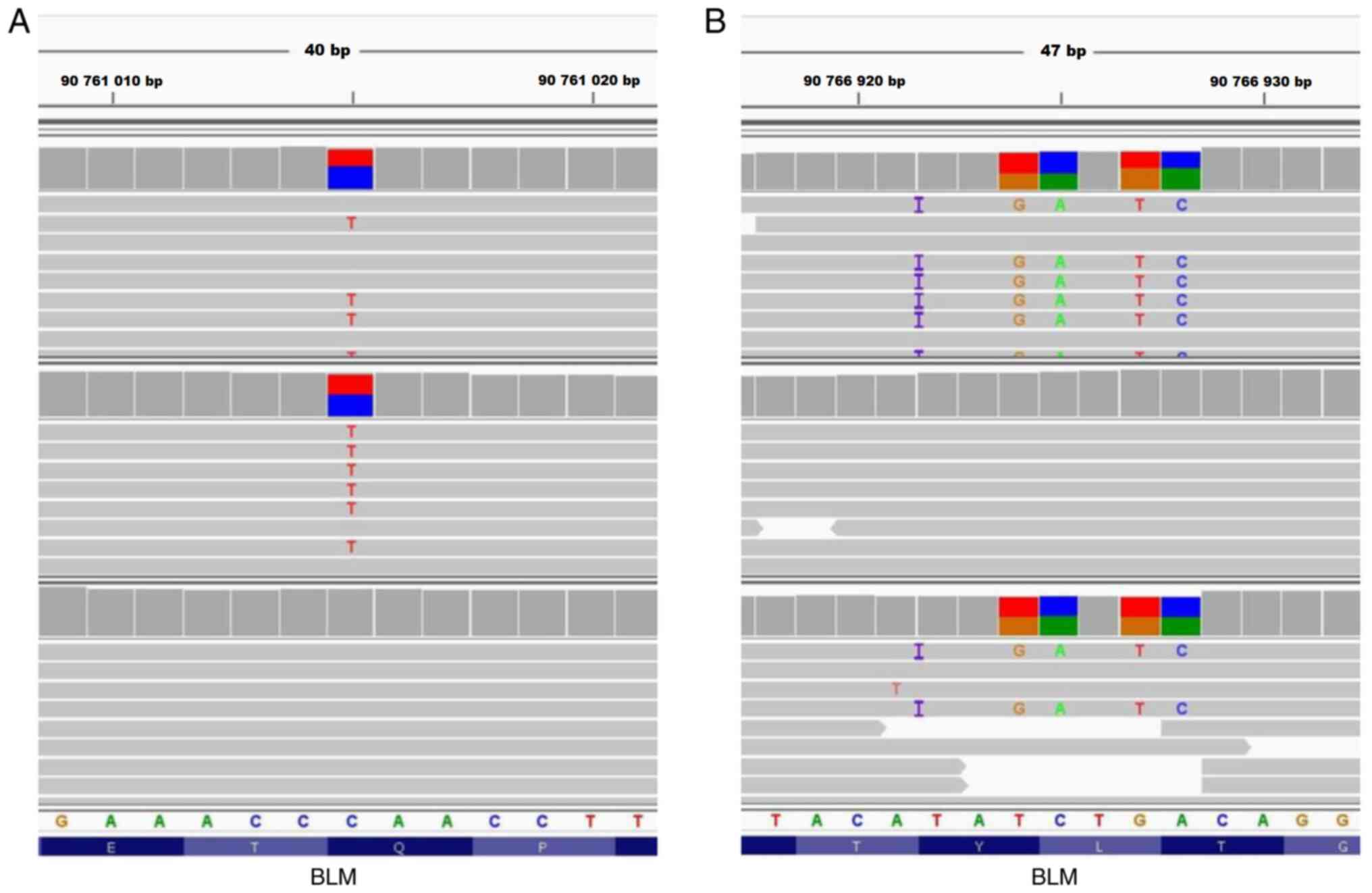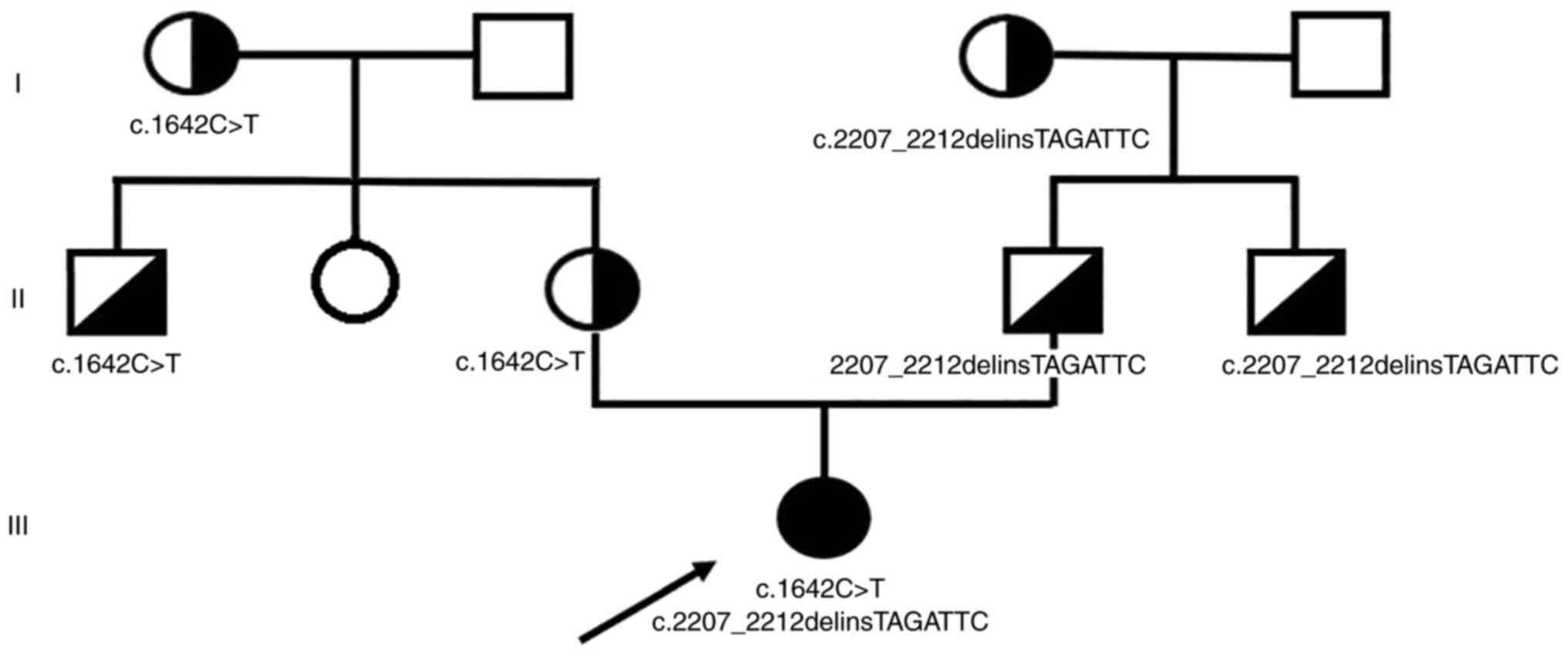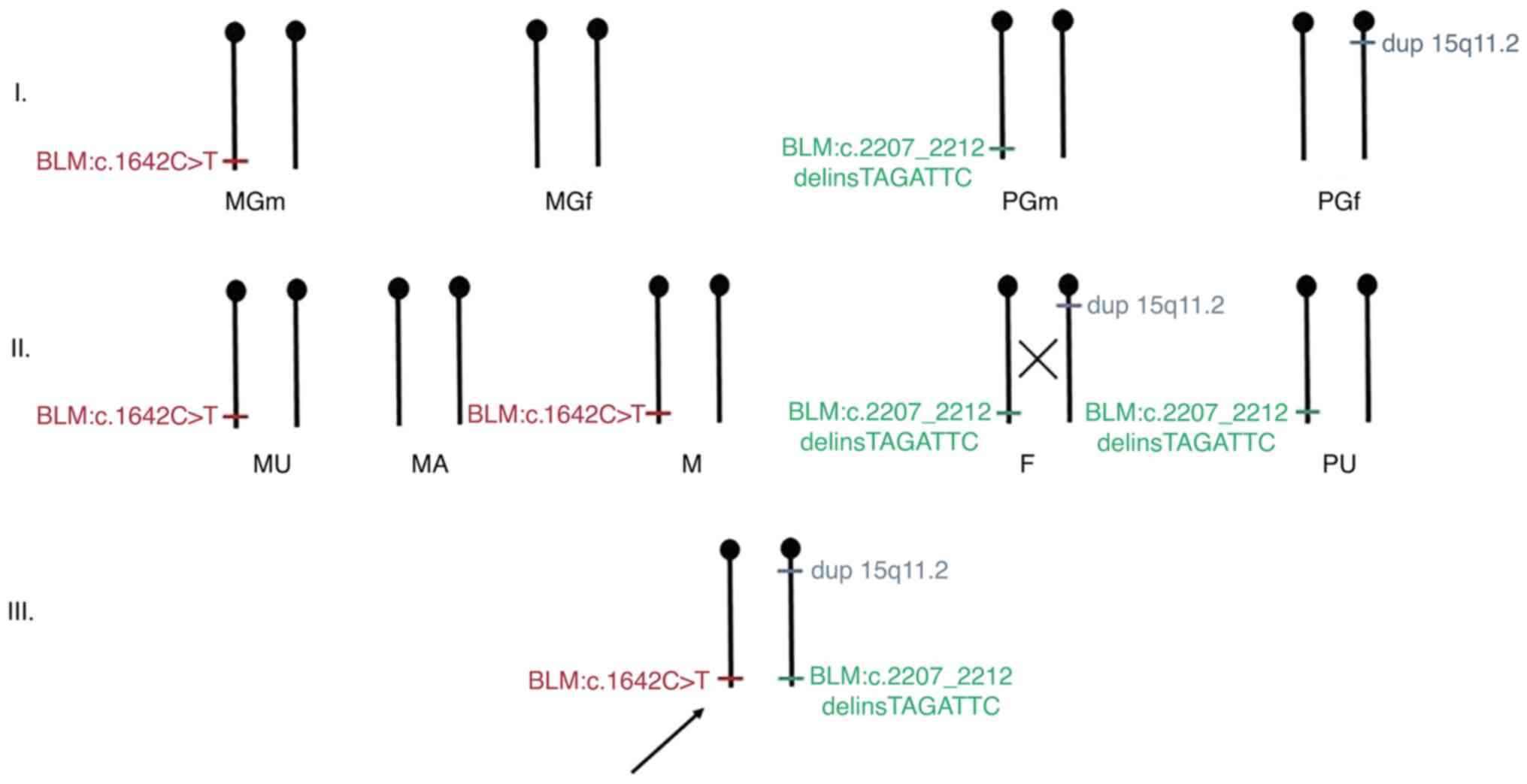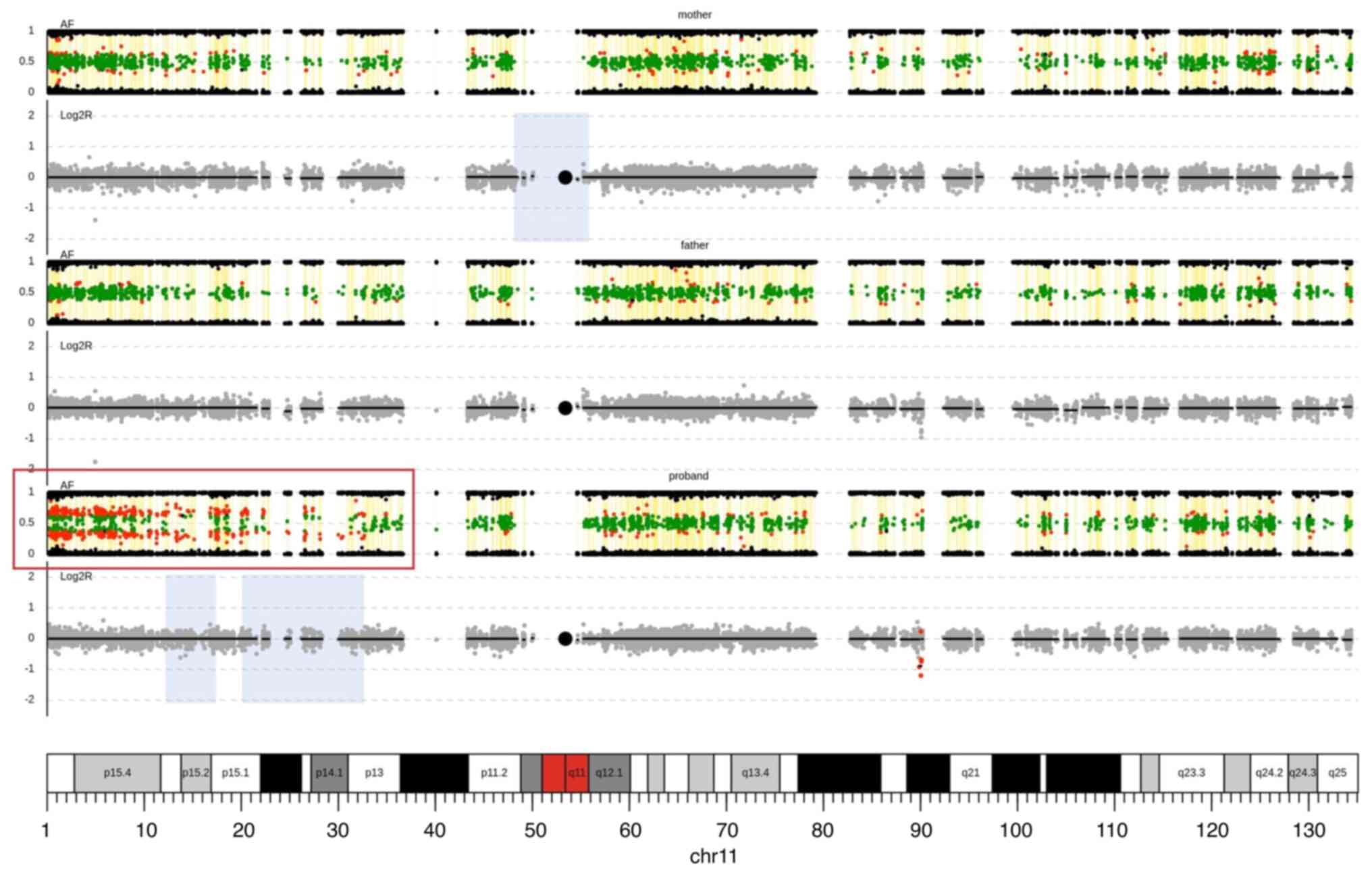|
1
|
Posey JE: Genome sequencing and
implications for rare disorders. Orphanet J Rare Dis. 14:1532019.
View Article : Google Scholar : PubMed/NCBI
|
|
2
|
Cummings BB, Marshall JL, Tukiainen T, Lek
M, Donkervoot S, Foley AR, Bolduc V, Waddell LB, Sandaradura SA,
O'Grady GL, et al: Improving genetic diagnosis in Mendelian disease
with transcriptome sequencing. Sci Transl Med. 9:eaal52092017.
View Article : Google Scholar : PubMed/NCBI
|
|
3
|
Patel DS, Misenko SM, Her J and Bunting
SF: BLM helicase regulates DNA repair by counteracting RAD51
loading at DNA double-strand break sites. J Cell Biol.
216:3521–3534. 2017. View Article : Google Scholar : PubMed/NCBI
|
|
4
|
Cunniff C, Bassetti JA and Ellis NA:
Bloom's syndrome: Clinical spectrum, molecular pathogenesis, and
cancer predisposition. Mol Syndromol. 8:4–23. 2017. View Article : Google Scholar : PubMed/NCBI
|
|
5
|
Traverso G, Bettergowda C, Kraus J,
Speicher MR, Kinzler KW, Vogelstein B and Lengauer C:
Hyper-recombination and genetic instability in BLM-deficient
epithelial cells. Cancer Res. 63:8578–8581. 2003.PubMed/NCBI
|
|
6
|
Vojta V: Rehabilitation des spastischen
infantilen syndroms. Eigene Methodik. Orthop Traumat. 12:557–562.
1965.
|
|
7
|
Howe B, Umrigar A and Tsien F: Chromosome
preparation from cultured cells. J Vis Exp.
28:e502032014.PubMed/NCBI
|
|
8
|
Livak KJ and Schmittgen TD: Analysis of
relative gene expression data using real-time quantitative PCR and
the 2(−Delta Delta-C(T)) method. Methods. 25:402–408. 2001.
View Article : Google Scholar : PubMed/NCBI
|
|
9
|
Wayhelova M, Vallova V, Broz P, Mikulasova
A, Loubalova D, Filkova H, Smetana J, Drabova K, Gaillyova R and
Kuglik P: Novel de novo pathogenic variant in the GNAI1 gene as a
cause of severe disorders of intellectual development. J Hum Genet.
67:209–214. 2022. View Article : Google Scholar : PubMed/NCBI
|
|
10
|
Chen S, Zhou Y, Chen Y and Gu J: fastp: An
ultra-fast-all-in-one FASTQ preprocessor. Bioinformatics.
34:i884–i890. 2018. View Article : Google Scholar : PubMed/NCBI
|
|
11
|
Li H and Durbin R: Fast and accurate short
read alignment with Burrows-Wheeler transform. Bioinformatics.
25:1754–1760. 2009. View Article : Google Scholar : PubMed/NCBI
|
|
12
|
Koboldt DC, Chen K, Wylie T, Larson DE,
McLellan MD, Mardis ER, Weinstock GM, Wilson RK and Ding L:
VarScan: Variant detection in massively parallel sequencing of
individual and pooled samples. Bioinformatics. 25:2283–2285. 2009.
View Article : Google Scholar : PubMed/NCBI
|
|
13
|
R Core Team (2020), . R: A language and
environment for statistical computing. R Foundation for Statistical
Computing; Vienna, Austria:
|
|
14
|
McLaren W, Gil L, Hunt SE, Riat HS,
Ritchie GRS, Thormann A, Flicek P and Cunningham F: The ensembl
variant effect predictor. Genome Biol. 17:1222016. View Article : Google Scholar : PubMed/NCBI
|
|
15
|
Landrum MJ, Lee JM, Benson B, Brown GR,
Chao C, Chitipiralla S, Gu B, Hart J, Hoffman D, Jang W, et al:
ClinVar: Improving access to variant interpretations and supporting
evidence. Nucleic Acids Res. 46:D1062–D1067. 2018. View Article : Google Scholar : PubMed/NCBI
|
|
16
|
Kopanos C, Tsiolkas V, Kouris A, Chapple
CE, Aguillera MA, Meyer R and Massouras A: VarSome: The human
genomic variant search engine. Bioinformatics. 35:1978–1980. 2019.
View Article : Google Scholar : PubMed/NCBI
|
|
17
|
Hamosh A, Scott AF, Amberger JS, Bocchini
CA and McKusick VA: Online mendelian inheritance in man (OMIM), a
knowledgebase of human genes and genetic disorders. Nucleic Acids
Res. 33:D514–D517. 2005. View Article : Google Scholar : PubMed/NCBI
|
|
18
|
Lappalainen I, Lopez J, Skipper L,
Hefferson T, Spalding JD, Garner J, Chen C, Maguire M, Corberr M,
Zhou G, et al: DbVar and DGVa: Public archives for genomic
structural variation. Nucleic Acids Res. 41:D936–D941. 2013.
View Article : Google Scholar : PubMed/NCBI
|
|
19
|
Kendall KM, Bracher-Smith M, Fitzpatrick
H, Lynham A, Rees E, Escott-Price V, Owen MJ, O'Donovan MC, Walters
JTR and Kirov G: Cognitive performance and functional outcomes of
pathogenic copy number variants: Analysis of the UK Biobank. Br J
Psychiatry. 214:297–304. 2019. View Article : Google Scholar : PubMed/NCBI
|
|
20
|
Miller DT, Lee K, Abul-Husn NS, Amendola
LM, Brothers K, Chung WK, Gollob MH, Gordon AS, Harrison SM,
Hershberger RE, et al: ACMG SF v3.1 list for reporting of secondary
findings in clinical exome and genome sequencing: A policy
statement of the American College of medical genetics and genomics
(ACMG). Genet Med. 24:1407–1414. 2022. View Article : Google Scholar : PubMed/NCBI
|
|
21
|
Li L, Eng C, Desnick RJ, German J and
Ellis NA: Carrier frequency of the Bloom syndrome blmAsh mutation
in the Ashkenazi Jewish population. Mol Genet Metab. 64:286–290.
1998. View Article : Google Scholar : PubMed/NCBI
|
|
22
|
Montenegro MM, Quaio CR, Palmeira P,
Gasparini Y, Rangel-Santos A, Damasceno J, Novak EM, Gimenez TM,
Yamamoto GL, Ronjo RS, et al: Gene expression profile suggesting
immunological dysregulation in two Brazilian Bloom's syndrome
cases. Mol Genet Genomic Med. 8:e11332020. View Article : Google Scholar : PubMed/NCBI
|
|
23
|
German J, Sanz MM, Ciocci S, Ye TZ and
Ellis NA: Syndrome-causing mutations of the BLM gene in persons in
the Bloom's syndrome registry. Hum Mutat. 28:743–753. 2007.
View Article : Google Scholar : PubMed/NCBI
|
|
24
|
Gönenc II, Elcioglu NH, Grijalva CM, Aras
S, Großmann N, Praulich I, Altmüller J, Kaulfuß S, Li Y, Nürnberg
P, et al: Phenotypic spectrum of BLM- and RMI1-related Bloom
syndrome. Clin Genet. 101:559–564. 2022. View Article : Google Scholar : PubMed/NCBI
|
|
25
|
Backers L, Parton B, De Bruyne M,
Tavernier SJ, Van Den Bogaert K, Lambrecht BN, Haerynck F and Claes
KBM: Missing heritability in Bloom syndrome: First report of a deep
intronic variant leading to pseudo-exon activation in the BLM gene.
Clin Genet. 99:292–297. 2021. View Article : Google Scholar : PubMed/NCBI
|
|
26
|
Gönenc II, Wolff A, Schmidt J, Zibat A,
Müller C, Cyganek L, Argyriou L, Räschle M, Yigit G and Wollnik B:
Single-cell transcription profiles in Bloom syndrome patients link
BLM deficiency with altered condensin complex expression
signatures. Hum Mol Genet. 31:2185–2193. 2022. View Article : Google Scholar : PubMed/NCBI
|
|
27
|
Suspitsin EN, Sibgatullina FI, Lyazina LV
and Imyanitov EN: First two cases of Bloom syndrome in Russia: Lack
of skin manifestation in a BLM c.1642C>T (p.Q548X) homozygote as
a likely cause of underdiagnosis. Mol Syndromol. 8:103–106. 2017.
View Article : Google Scholar : PubMed/NCBI
|
|
28
|
Trizuljak J, Petruchová T, Blaháková I,
Vrzalová Z, Hořínová V, Doubková M, Michalka J, Mayer J,
Pospíšilová Š and Doubek M: Diagnosis of Bloom syndrome in a
patient with short stature, recurrence of malignant lymphoma, and
consanguineous origin. Mol Syndromol. 11:73–82. 2020. View Article : Google Scholar : PubMed/NCBI
|
|
29
|
Wan L, Han J, Liu T, Dong S, Xie F, Chen H
and Huang J: Scaffolding protein SPIDR/KIAA0146 connects the Bloom
syndrome helicase with homologous recombination repair. Proc Natl
Acad Sci USA. 110:10646–10651. 2013. View Article : Google Scholar : PubMed/NCBI
|
|
30
|
Sokolenko AP, Iyevleva AG,
Preobrazhenskaya EV, Mitiushkina NV, Abysheva SN, Suspitsin EN,
Kuligina ES, Gorodnova TV, Pfeifer W, Togo AV, et al: High
prevalence and breast cancer predisposing role of the BLM
c.1642C>T (Q548X) mutation in Russia. Int J Cancer.
130:2867–2873. 2012. View Article : Google Scholar : PubMed/NCBI
|
|
31
|
Prokofyeva D, Bogdanova N, Dubrowinskaja
N, Bermisheva M, Takhirova Z, Antonenkova N, Turmanov N, Datsyuk I,
Gantsev S, Christiansen H, et al: Nonsense mutation p.Q548X in BLM,
the gene mutated in Bloom's syndrome, is associated with breast
cancer in Slavic population. Breast Cancer Res Treat. 137:533–539.
2013. View Article : Google Scholar : PubMed/NCBI
|
|
32
|
Shahrabani-Gargir L, Shomrat R, Yaron Y,
Orr-Urteger A, Groden J and Legum C: High frequency of a common
Bloom syndrome Ashkenazi mutation among Jews of polish origin.
Genet Test. 2:293–296. 1998. View Article : Google Scholar : PubMed/NCBI
|
|
33
|
Huson SM, Staab T, Pereira M, Ward H,
Paredes R, Evans DG, Baumhoer D, O'Sullivan J, Cheesman E,
Schindler D and Meyer S: Infantile fibrosarcoma with TPM3-NTRK1
fusion in a boy with Bloom syndrome. Fam Cancer. 21:85–90. 2022.
View Article : Google Scholar : PubMed/NCBI
|
|
34
|
Fiala EM, Ortiz MV, Kennedy JA, Glodzik D,
Fleischut MH, Duffy KA, Hathaway ER, Heaton T, Gerstle JT,
Steinherz P, et al: 11p15.5 epimutations in children with Wilms
tumor and hepatoblastoma detected in peripheral blood. Cancer.
126:3114–3121. 2020. View Article : Google Scholar : PubMed/NCBI
|
|
35
|
Ibrahim A, Kirby G, Hardy C, Dias RP, Tee
L, Lim D, Berg J, MacDonald F, Nightingale P and Maher ER:
Methylation analysis and diagnostics of Beckwith-Wiedemann syndrome
in 1,000 subjects. Clin Epigenetics. 6:112014. View Article : Google Scholar : PubMed/NCBI
|
|
36
|
Van Veghel-Plandsoen MM, Wouters CH,
Kromosoeto JNR, den Ridder-Klünnen MC, Halley DJJ and van den
Ouweland AMW: Multiplex ligation-depending probe amplification is
not suitable for detection of low-grade mosaicism. Eur J Hum Genet.
19:1009–1012. 2011. View Article : Google Scholar : PubMed/NCBI
|
|
37
|
Brioude F, Kalish JM, Mussa A, Foster AC,
Bliek J, Ferrero GB, Boonen SE, Cole T, Baker R, Bertoletti M, et
al: Expert consensus document: Clinical and molecular diagnosis,
screening and management of Beckwith-Wiedemann syndrome: An
international consensus statement. Nat Rev Endocrinol. 14:229–249.
2018. View Article : Google Scholar : PubMed/NCBI
|
|
38
|
LaRocque JR, Stark JM, Oh J, Bojilova E,
Yusa K, Horie K, Takeda J and Jasin M: Interhomolog recombination
and loss of heterozygosity in wild-type and Bloom syndrome helicase
(BLM)-deficient mammalian cells. Proc Natl Acad Sci USA.
108:11971–11976. 2011. View Article : Google Scholar : PubMed/NCBI
|
|
39
|
Bouman A, van Koningsbruggen S,
Karakullukcu MB, Schreuder WH and Lakeman P: Bloom syndrome does
not always present with sun-sensitive facial erythema. Eur J Med
Genet. 61:94–97. 2018. View Article : Google Scholar : PubMed/NCBI
|
|
40
|
MacFarland SP, Duffy KA, Bhatti TR,
Bagatell R, Balamuth NJ, Brodeur GM, Ganguly A, Mattei PA, Surrey
LF, Balis FM and Kalish JM: Diagnosis of beckwith-wiedemann
syndrome in children presenting with wilms tumor. Pediatr Blood
Cancer. 65:e272962018. View Article : Google Scholar : PubMed/NCBI
|
|
41
|
Alders M, Maas SM, Kadouch DJM, var der
Lip K, Bliek J, van der Horst CMAM and Mannens MMAM: Methylation
analysis in tongue tissue of BWS patients identifies the
(EPI)genetic cause in 3 patients with normal methylation levels in
blood. Eur J Med Genet. 57:293–297. 2014. View Article : Google Scholar : PubMed/NCBI
|
|
42
|
Campbell MB, Campbell WC, Rogers J, Rogers
N, Rogers Z, van den Hurk AM, Webb A, Webb T and Zaslaw P: Bloom
syndrome: Research and data priorities for the development of
precision medicine as identified by some affected families. Cold
Spring Harb Mol Case Stud. 4:a0028162018. View Article : Google Scholar : PubMed/NCBI
|
|
43
|
Robinson JT, Thorvaldsdóttir H, Winckler
W, Guttman M, Lander ES, Getz G and Mesirov JP: Integrative
Genomics Viewer. Nat Biotechnol. 29:24–26. 2011. View Article : Google Scholar : PubMed/NCBI
|


















